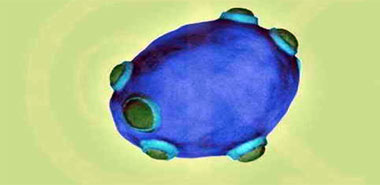
加拿大麦吉尔大学生物化学系研究人员发现,与核糖核酸相结合的一种蛋白质片断能够控制基因的正常表达,其中包括那些在癌症中活跃的基因。专家认为,这是癌症研究工作的一项重要突破,可立即将其应用到实验室的研究工作中,并且使目前各国科学家广泛开展的癌症个性化治疗工作向前推进了一大步。相关研究成果发表在5月26日《自然》杂志网络版上。
人类细胞需要在合适的时间生产出适度数量的正常蛋白以维持其健康。细胞对蛋白生产进行有效控制时,所采用的重要手段之一就是依靠RNAi干扰。RNAi干扰是基因沉默的一种形式,即小片段RNA(又称microRNA)与它们的遗传密码结合,以阻断特殊蛋白的生产。然而,不是RNA的任何片段都能够按此方式行事。
麦吉尔大学的哈桑拉贾尔博士与同事合作,使用结构生物学揭开了Argonaute蛋白中的一小段,即RNAi干扰的关键分子如何能够选择正确的微核糖核酸的奥秘。
研究人员发现,RNAi干扰可以促使Argonaute蛋白增加基因静默。拉贾尔博士认为,RNAi干扰可以作为可行的治疗方法,来抑制那些在癌症等疾病中显得特别活跃的特殊基因。他表示现在已经掌握了修改微核糖核酸的方法,可以使其更具效力,并有希望基于此开发出治疗药物。研究人员认为,该发现要进入实际治疗还需时日,但它为有目的地控制那些非正常蛋白的生产提供了有效方法。
麦吉尔大学生化系主任汤姆斯博士认为,医学界一直期盼有朝一日可以结束依靠化疗方法治疗癌症,而该项发现朝着癌症患者个性化基因治疗方向迈出了重要的一步。
生物谷推荐原文出处:
Nature doi:10.1038/nature09039
Structural basis for 5′-nucleotide base-specific recognition of guide RNA by human AGO2
Filipp Frank1,2,3, Nahum Sonenberg1,2 " Bhushan Nagar1,3
1Department of Biochemistry, McGill University, Montréal, Québec H3G 0B1, Canada
2Goodman Cancer Center, McGill University, Montréal, Québec H3G 0B1, Canada
3Groupe de Recherche Axe sur la Structure des Proteines, Montréal, Québec H3G 0B1, Canada
MicroRNAs (miRNAs) mediate post-transcriptional gene regulation through association with Argonaute proteins (AGOs)1. Crystal structures of archaeal and bacterial homologues of AGOs have shown that the MID (middle) domain mediates the interaction with the phosphorylated 5′ end of the miRNA guide strand and this interaction is thought to be independent of the identity of the 5′ nucleotide in these systems2, 3. However, analysis of the known sequences of eukaryotic miRNAs and co-immunoprecipitation experiments indicate that there is a clear bias for U or A at the 5′ position4, 5, 6, 7. Here we report the crystal structure of a MID domain from a eukaryotic AGO protein, human AGO2. The structure, in complex with nucleoside monophosphates (AMP, CMP, GMP, and UMP) mimicking the 5′ end of miRNAs, shows that there are specific contacts made between the base of UMP or AMP and a rigid loop in the MID domain. Notably, the structure of the loop discriminates against CMP and GMP and dissociation constants calculated from NMR titration experiments confirm these results, showing that AMP (0.26 mM) and UMP (0.12?mM) bind with up to 30-fold higher affinity than either CMP (3.6?mM) or GMP (3.3?mM). This study provides structural evidence for nucleotide-specific interactions in the MID domain of eukaryotic AGO proteins and explains the observed preference for U or A at the 5′ end of miRNAs.







